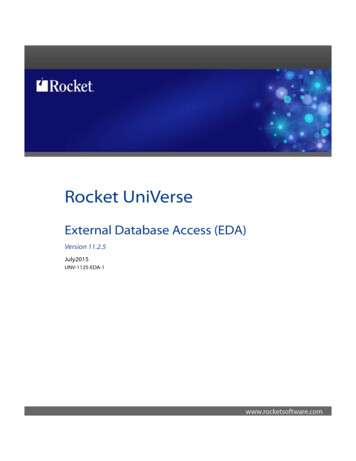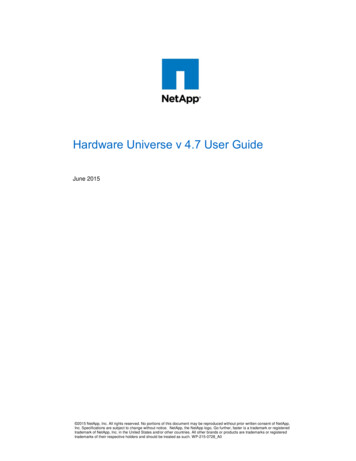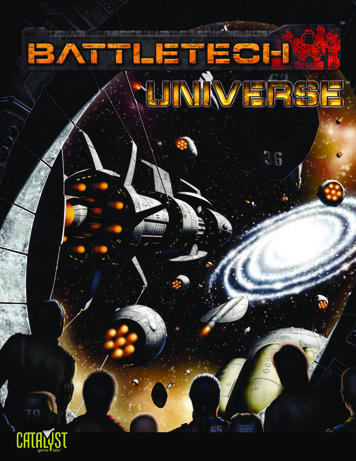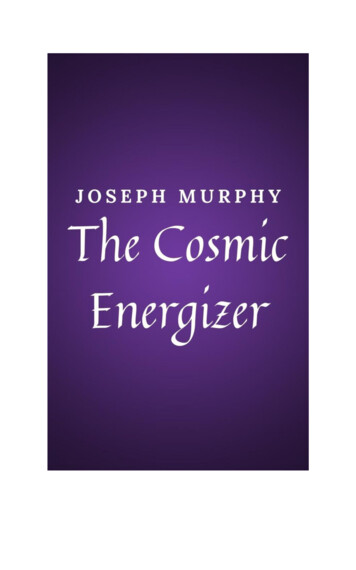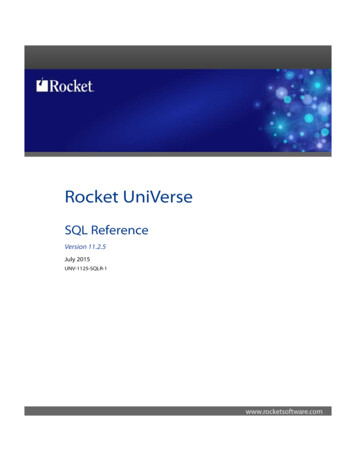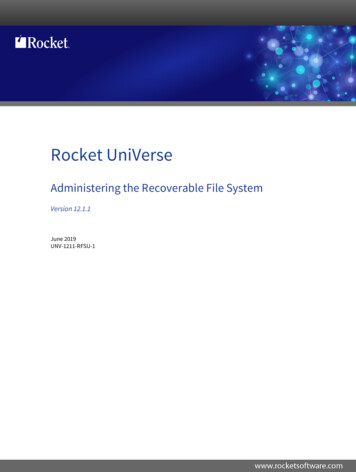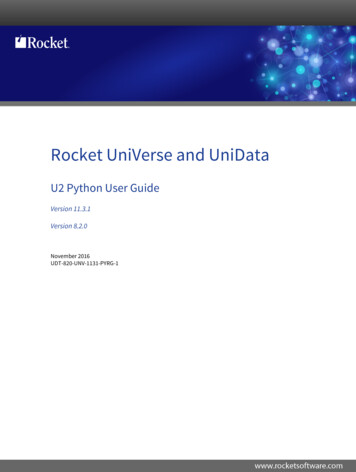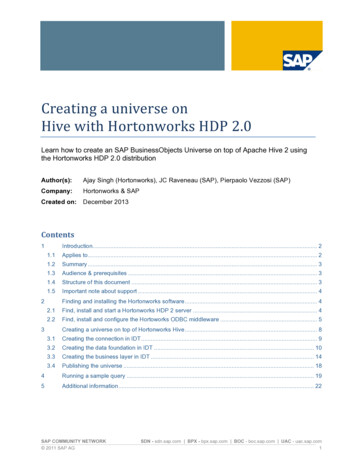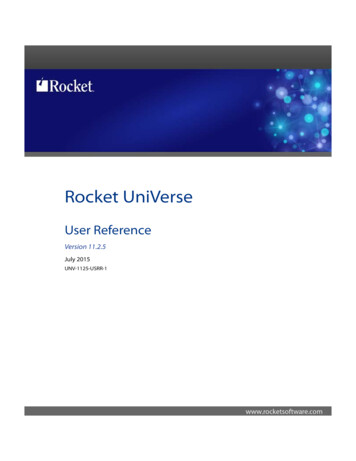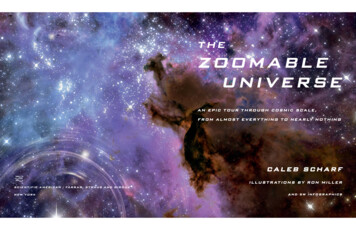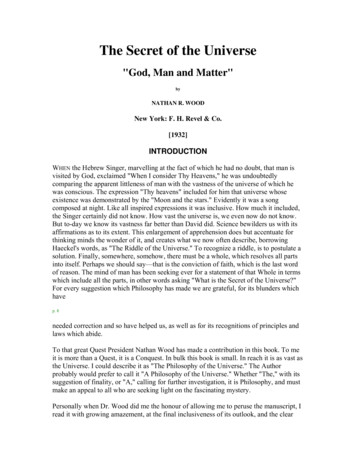
Transcription
The Secret of the Universe"God, Man and Matter"byNATHAN R. WOODNew York: F. H. Revel & Co.[1932]INTRODUCTIONWHEN the Hebrew Singer, marvelling at the fact of which he had no doubt, that man isvisited by God, exclaimed "When I consider Thy Heavens," he was undoubtedlycomparing the apparent littleness of man with the vastness of the universe of which hewas conscious. The expression "Thy heavens" included for him that universe whoseexistence was demonstrated by the "Moon and the stars." Evidently it was a songcomposed at night. Like all inspired expressions it was inclusive. How much it included,the Singer certainly did not know. How vast the universe is, we even now do not know.But to-day we know its vastness far better than David did. Science bewilders us with itsaffirmations as to its extent. This enlargement of apprehension does but accentuate forthinking minds the wonder of it, and creates what we now often describe, borrowingHaeckel's words, as "The Riddle of the Universe." To recognize a riddle, is to postulate asolution. Finally, somewhere, somehow, there must be a whole, which resolves all partsinto itself. Perhaps we should say—that is the conviction of faith, which is the last wordof reason. The mind of man has been seeking ever for a statement of that Whole in termswhich include all the parts, in other words asking "What is the Secret of the Universe?"For every suggestion which Philosophy has made we are grateful, for its blunders whichhavep. 8needed correction and so have helped us, as well as for its recognitions of principles andlaws which abide.To that great Quest President Nathan Wood has made a contribution in this book. To meit is more than a Quest, it is a Conquest. In bulk this book is small. In reach it is as vast asthe Universe. I could describe it as "The Philosophy of the Universe." The Authorprobably would prefer to call it "A Philosophy of the Universe." Whether "The," with itssuggestion of finality, or "A," calling for further investigation, it is Philosophy, and mustmake an appeal to all who are seeking light on the fascinating mystery.Personally when Dr. Wood did me the honour of allowing me to peruse the manuscript, Iread it with growing amazement, at the final inclusiveness of its outlook, and the clear
and cogent statement of its examination of those parts which interpret the whole. The firstthree parts of the book are as fascinating as a Fairy Story. That perhaps is an unfortunatefigure of speech as it may suggest something fanciful. I employ it rather in the sense thattruth is stranger than fiction. The final part requires more careful, or shall I say slowerreading, as the Author gives us a keen and penetrative analysis of the Universe.It is not the work of an introduction to give away a "secret." That must be discovered bythe reader of the book. At least I do not hesitate to say here is a book, startling,challenging, scholarly, sane, courteous; and it must make its appeal to the considerationof those who are not content to drift through life taking things as they are, but desire tochallenge life, not only in its passing hours, and nearest dust, but in its vastness andentirety. In this age, when Philosophyp. 9has really had nothing new to say for many generations, but has been satisfied withgarbing in new terminology the thinking of other days, here is a book which will surelymake men stop-look-and-listen. I would like to put a copy first in the hands of everytheological student, and then also in the hands of every student who is endeavoring to"beat his music out."CONTENTSPART I. THE PATTERN OF THE UNIVERSEI. THE OUTER UNIVERSEII. THE INNER UNIVERSEIII. THE DEMAND OF THE UNIVERSEPART II. THE PROBLEMS OF THE UNIVERSEINTRODUCTION. THE SECRET OF ALL THINGSI. THE PROBLEM OF UNITYII. THE PROBLEM OF SPACE AND MOTIONIII. THE PROBLEM OF SPACE, MOTION AND TIMEIV. THE PROBLEM OF RELATIVITYV. THE PROBLEM OF BEING, OR EXISTENCEVI. THE PROBLEM OF CHANGE AND PROGRESSVII. THE PROBLEM OF ETHICS, OR THE GOODVIII. THE PROBLEM OF REALITY, OR THE TRUEIX. THE PROBLEM OF AESTHETICS, OR THE BEAUTIFULCONCLUSION. THE SECRET OF THE UNIVERSE AND THE RIDDLES OF THEUNIVERSE
PART I. THE PATTERN OF THE UNIVERSEI. THE OUTER UNIVERSEWhy is the universe what it is?—Is it really a universe?—What is its structure?—The basic things—Space—Matter—Time—"Is there a universal principle?"—The Equation of the Universe—How far doesthe structure of the universe extend?—How the being of God was presented to us—The Data classified—What Space is—What Matter is—What Time is—The Structure of the Universe—How the cause explainsthe structure—How the structure confirms the cause—The vision of the universe.WHY is the universe what it is? That is the riddle of the universe. Can we ever solve it?Can we grasp it at all? Of course we cannot with human minds reach out to the everreceding infinities of universe beyond universe of stars. Neither can we reach inward tothe equal infinities of world within world in the atom. This does not need words. Weknow that we can never do it. We cannot grasp what it really means that a certain islanduniverse is millions of light-years away. We cannot grasp what it means that the electronmoves in its orbit around the proton in the atom a quadrillion times a second. It is noshame to us that we cannot grasp such things as these. Our minds are not geared to theinfinite. If they were, could we harness them any more to the ledger, the plough, the toolchest or the cook-stove? What would it profit to grasp the nebula and the electron, andstarve or freeze? But our minds do seemp. 14fitted to understand. They can apparently understand the quality and meaning of thingswhose immensity they cannot grasp. They are evidently fitted to understand everythingwhich can be understood. That seems somehow to be what they are for.Then can we understand the universe? Can we find why it is what it is? That surelycomes first in understanding it. Can we find an organic reason in it, and see it as a whole?Some put it in this way:—"Is there a formula of the universe? And can the formula beknown?" It is worth every effort to understand this force or that fact in the world aroundus. What then is it worth to understand the universe!Why is the physical world just what it is, and not something quite different? Could thephysical world have existed in some other form and order? If it could have been whollydifferent, why is it what it is? Or if it had to be what it is, why did it have to be so? Isthere a reason? What is the reason?It is not enough to say that all things evolved into this present form of things out of asimpler condition. For if they did evolve, why did they evolve into this order of things,and not into something quite different? That is our question. Or if they came at a creativestroke into what they now are, why was it into just this form and character and not intosome other?Is this really a universe, then? That is, has it unity? Has it a structure, with a reason forthe structure? For we surely do want, if we can, to see the universe as a whole. If we
cannot see it all, which is a more than doubtful possibility, we can at least see what it allmeans. Can we see it as a universe, a genuine unity, including the world of matter and thep. 15world of mind? Is it such a universe, with an organic pattern and principle in it all? Inother words, is there a structure of the universe, with a reason for it? What is thatstructure?If we had not asked these things before, modern science would drive us to ask them now.This physical universe, this vast fabric of forces, this interplay of laws and energies, whyis it so precisely and accurately what it is? There must be a structure of the modernuniverse. And if there is such a structure, there must be a reason for it, a universal reasonwhy it is just what it is. What is that reason?To find the structure of the physical universe, we do not need more complicatedknowledge. We need to simplify. We need to use what we have. We must find the basicthings, which form the universal structure.What are the basic things? Those things which lie back of all other things? Those thingswhich are the basis of all other things, and include all other things, and exist in all otherthings? Those will be the basic things. They should not be very hard to find. When wehave found them we shall be on our way toward understanding the riddle of the universe.We must find the basic things.SpaceThe first one may be agreed upon without difficulty. It is Space—the basic thing in thephysical universe. It is back of every other basis of the physical universe. We may havemany different views about space, and many speculations. We may think of space as anoutward reality, or as our way of seeing the universe. But, in any case, space comes first.Upon one thing wep. 16can all agree. Whatever each of us may mean by space, this is, as we all know, a spaceuniverse.What is space? Of what does it consist?We may speculate much about this. But again we can without difficulty agree on theessential thing. Space as we all know it and live in it and use it consists of three things.We call these three things three dimensions, or three directions. We name them generallylength, breadth and height.
Two words may be objected to nowadays, when we talk about "three dimensions." Oneword is "dimensions," and the other is "three." But for our simpler and basic purposeneither objection will be made.It may be suggested, and rightly, that the term "dimensions," the term most commonlyused, and which therefore we are using, means measurements, and therefore implieslimited distances. "Length, breadth and height," too, may be taken as limited terms."Length" may mean the distance between two definite points, which means a limiteddistance. "Breadth" also may be used as a term of measurement, rather than a term ofunlimited direction. "Height" also may signify a limited distance upward. These terms arenot wholly unambiguous when we would signify unlimited space. It would be moreunmistakably accurate to say "directions" instead of "dimensions." Space has three"independent directions," the mathematician says. Those words do not carry the possiblemeaning of measurement, as "dimensions" do. But it is difficult to name the threedirections. Shall we call them "north," "east" and "up?" Or x, y and z? These are accurate.But people in general are not accustomed to these terms. They arep. 17on the contrary accustomed to saying "dimensions" when they mean unlimited"directions," and to saying "length," "breadth" and "height" when they mean the threegeneral "directions" of unlimited space. May we not, then, use the terms to which mostreaders are accustomed, so accustomed that these terms are second nature to them whenthey think about the directions of space. But may we mean by these terms, not the limitedmeasurements of a box, or house, or geometric figure, but the unlimited "dimensions" offree space. That is what the mathematician means by "three independent directions," andit is what the ordinary person means by the "three dimensions of space," and it is what themathematician means when he talks about a "fourth dimension."In this sense of the terms, space as we know it and live in it and use it consists of threethings. They are three dimensions,—length, breadth and height. As we have said, we mayspeculate about space. Mathematicians may demonstrate a fourth dimension and fifthdimension, and some profound realities may or may not reside in the demonstrations. Butwhen we build a house we build it in three dimensions. No man in the world has everraised a cabin or a cathedral of either more or less than three dimensions. No thinkerwould know how to plan a structure of more than three dimensions. Whatever therefinements, the subtleties, of space may be, it is clear that the basic space, the space ofcommon knowledge and experience, is of three dimensions. It consists of thosedimensions. It is length, breadth and height. This is the first thing in the structure of thephysical universe.p. 18MatterWhat else does the universe around us tell us of the basic things? What else is thestructure of the physical universe? Of what else does it consist?
That too is a matter of common knowledge and experience. The man who moves aboutunthinking in the physical world and the man who spends restless days and sleeplessnights in exploring the secrets of the physical world are at one in this.Next to space is that which fills space and embodies space, and gives to us all thephenomena of the physical universe. We call it matter. But we know now that it isprimarily energy. We can agree to call it matter, if by matter we mean that form whichenergy takes so that we can see it, or hear it, or feel it. We mean all of that which fills andgives outward reality to space. We all of us take this for granted in all of our dailythinking and activity.What is the nature then of this which occupies space, and makes a visible, audible,tangible universe? Of what does it consist?Here again we are among things which we know. For even if we avoid hypothesis andspeculation there is much which now we definitely know.Modern physics and chemistry find, first and basic in matter:—energy,—vast, unknown,unseen, a primal thing, out of which all things in the physical universe come.We may, it is true, define energy as "mass multiplied by the square of the velocity." Thatis the technical description of it. But that does not mean that this energy is the result ofthe multiplication of mass by itsp. 19velocity. Rather the energy is itself the cause. Mass may be, and doubtless is, simply amanifestation of that energy. And the velocity is surely a result, a manifestation, of thatenergy. "Mass times the square of the velocity" then is not what energy is. It is the waywe measure energy. We measure energy by its manifestations, of mass and velocity.Second, modern physics and chemistry find, growing out of energy, embodyingenergy,—motio
The Secret of the Universe "God, Man and Matter" by NATHAN R. WOOD New York: F. H. Revel & Co. [1932] INTRODUCTION WHEN the Hebrew Singer, marvelling at the fact of which he had no doubt, that man is visited by God, exclaimed "When I consider Thy Heavens," he was undoubtedly comparing the apparent littleness of man with the vastness of the universe of which he was conscious. The
